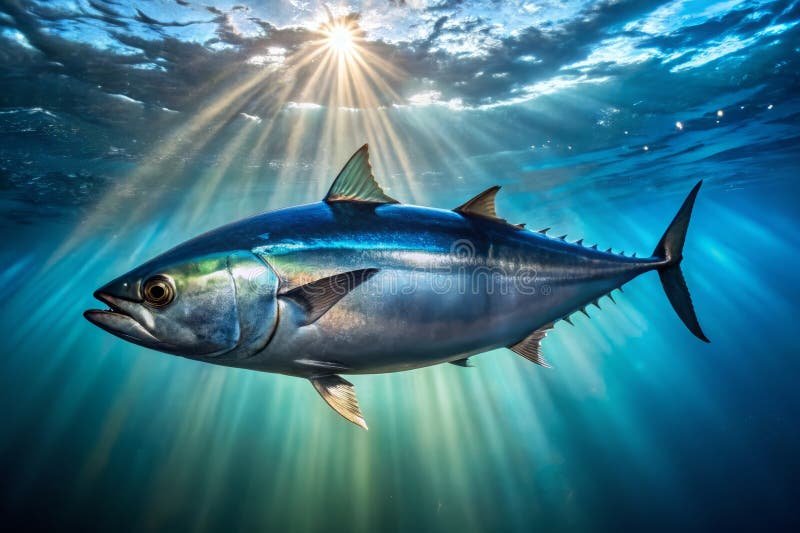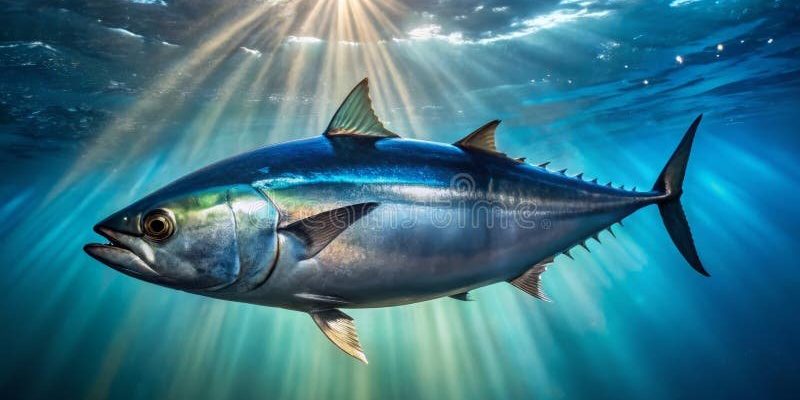
The bluefin tuna’s ability to navigate and communicate is a blend of biological instincts and environmental awareness. They use a combination of sensory perceptions, learned behaviors, and possibly even social cues to thrive in their habitats. Just like how we might follow landmarks or listen to directions, bluefin tuna have their own methods to make sense of their environment. So, let’s dive deeper into how these incredible fish work with their surroundings to find their way and talk to each other.
The Bluefin Tuna’s Unique Anatomy
To understand how bluefin tuna navigate and communicate, we first need to look at their amazing anatomy. These fish are built for speed and endurance, with a streamlined body that helps them swim long distances without much effort. Their muscles are specially adapted to sustain high-speed swimming, which is crucial for both hunting and avoiding predators.
One of the most fascinating features of the bluefin tuna is its lateral line system. This line runs along the sides of their bodies and consists of tiny sensory cells that pick up vibrations and movement in the water. It’s like having a built-in sonar system! This allows bluefin tuna to detect changes in their environment, from the rush of water created by a passing predator to the subtle movements of prey. Their powerful eyesight also plays a role in navigation, helping them spot landmarks and potential food sources from afar.
But there’s more. The bluefin tuna also has special adaptations for maintaining body temperature. Unlike many fish, they can regulate their internal body heat. This ability, known as regional endothermy, allows them to swim in colder waters while still being active, enabling them to explore vast regions of the ocean where other species might struggle.
Navigating the Open Ocean
When it comes to navigation, bluefin tuna rely on a mix of environmental cues and instinctual behavior. These fish often migrate thousands of miles, following currents and food availability. Think of it like traveling the world but using the ocean’s currents as your roadmap!
One key aspect of their navigation is the Earth’s magnetic field. Some researchers suggest that bluefin tuna can sense magnetic fields, helping them to orient themselves on long journeys. It’s like how birds use the Earth’s magnetism to find their way during migration. This innate ability gives bluefin tuna a significant advantage when it comes to navigating vast oceans where familiar landmarks are scarce.
Additionally, they also use water temperature and salinity as guides. Different areas of the ocean have varying temperatures and salt concentrations, which can signal to the tuna where they are and where they might want to go. By understanding these environmental factors, they can make informed decisions about their route and feeding grounds.
The Role of Social Behavior
Communication among bluefin tuna is a crucial part of their survival. Unlike some solitary species, these fish often travel in groups, known as schools. Being in a school offers protection from predators and increases hunting efficiency for group feeding.
But how do they communicate? Bluefin tuna use a combination of body language and sounds. For instance, they can produce low-frequency sounds by vibrating their swim bladders. These noises can signal various intentions, from mating to warning other fish of danger. Imagine them having an underwater conversation, albeit in a language we can’t quite hear!
Body movements also play a role in their social interactions. Quick, sudden changes in direction can signal excitement or alertness to other fish in the school. So, while we might speak or gesture to convey messages, bluefin tuna do the same through their movements and sounds while navigating through their environment.
Understanding Environmental Cues
Bluefin tuna are keen observers of their surroundings, using environmental cues to make decisions. They’re incredibly responsive to changes in their habitat, such as water temperature shifts, currents, and the presence of other marine life.
For example, when they sense a school of fish nearby, they might adjust their swimming patterns to follow the current and catch their prey more effectively. This ability to read the ocean around them is essential for hunting and avoiding getting lost.
Moreover, the time of day can influence their behavior. During the daytime, bluefin tuna might hunt at deeper levels where it’s cooler, while at night, they tend to swim closer to the surface. This adaptability shows how they use natural rhythms, like light and temperatures, to find food and navigate.
The Impact of Human Activity
As we explore how bluefin tuna navigate and communicate, it’s important to recognize the impacts of human activity on their environments. Overfishing and ocean pollution can drastically alter their habitats. These changes can affect their migration patterns, food sources, and even their ability to communicate.
When tuna populations decline, their social structures can break down. Smaller schools may form, which can lead to less effective hunting and higher vulnerability to predators. Additionally, if pollution changes the water quality or temperature patterns, it may confuse their navigational systems. This means they could lose their way or struggle to find food, which is concerning for their survival.
Protecting bluefin tuna and their habitats is essential for maintaining the balance in ocean ecosystems. Efforts like sustainable fishing practices and marine protected areas can help preserve their natural behaviors and habitats. So, when we talk about navigation and communication, we should also think about how we can help preserve these incredible creatures and their way of life.
The bluefin tuna is a magnificent example of nature’s design, brilliantly equipped to navigate the vast expanses of the ocean and communicate within their social structures. With their unique anatomy, sensory capabilities, and social behaviors, these fish thrive in a challenging environment.
As we appreciate how the bluefin tuna interacts with its world, let’s also consider our role in protecting these amazing animals and their habitats. By fostering a deeper understanding of their behaviors and needs, we can ensure that future generations will continue to marvel at the incredible journey of the bluefin tuna in our oceans.

